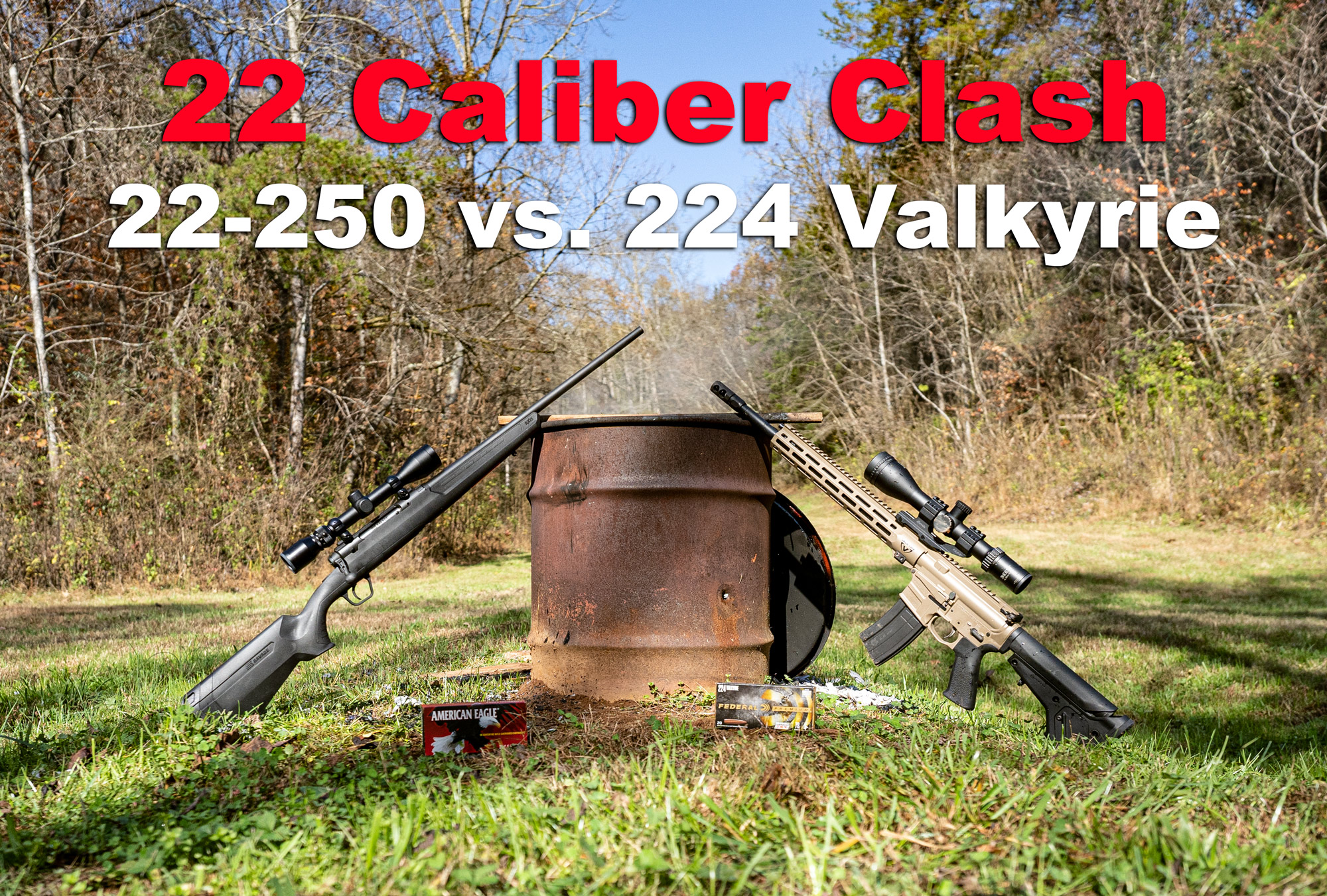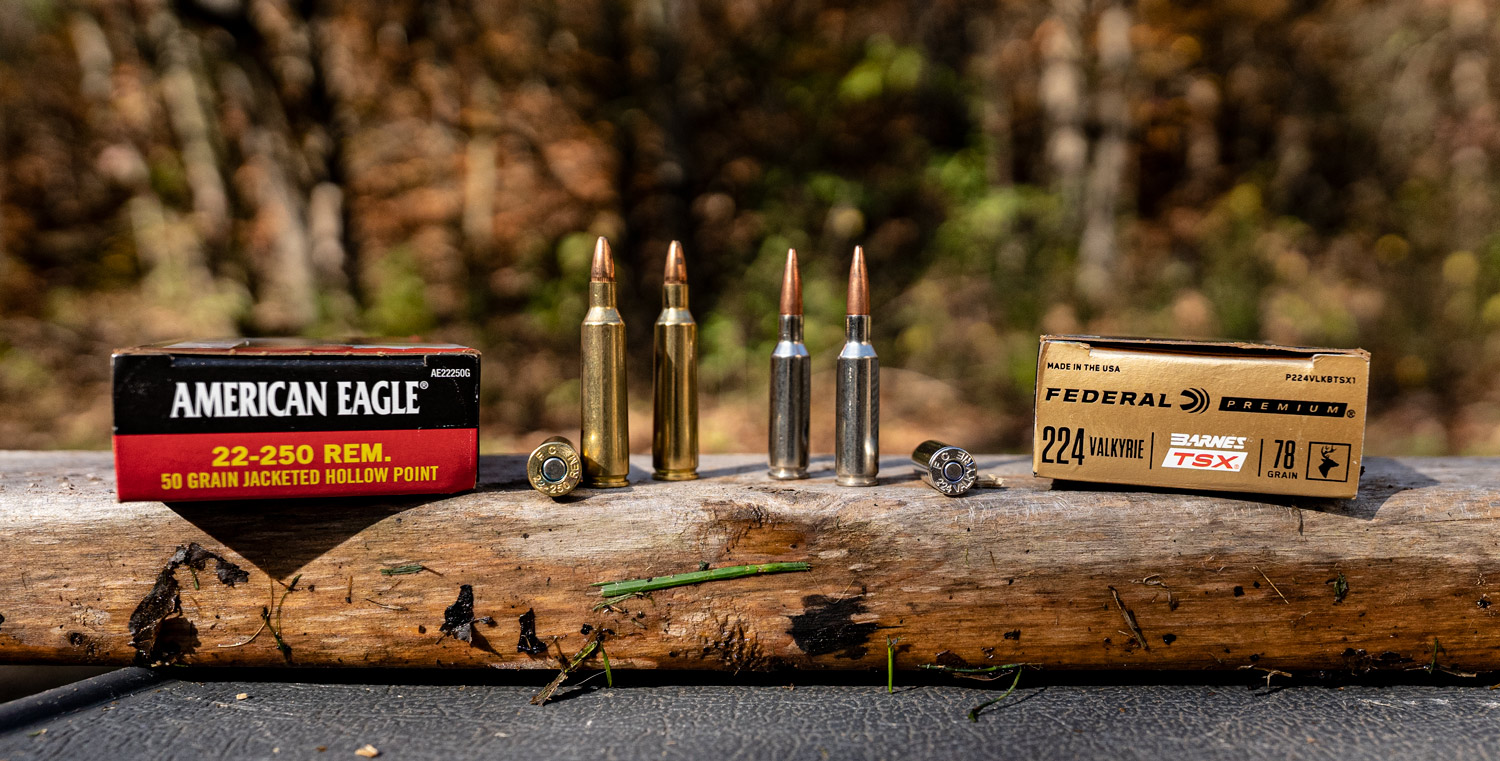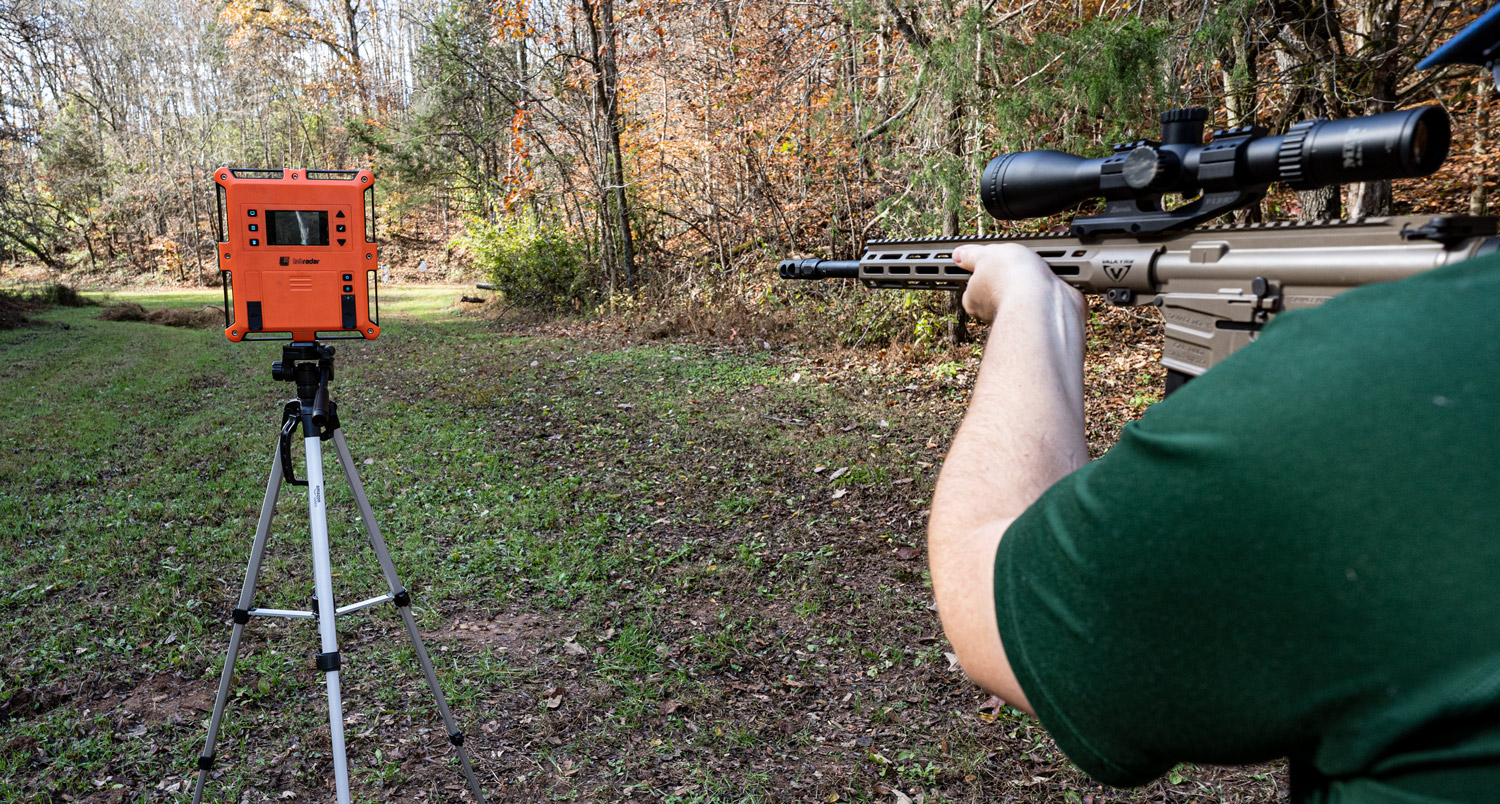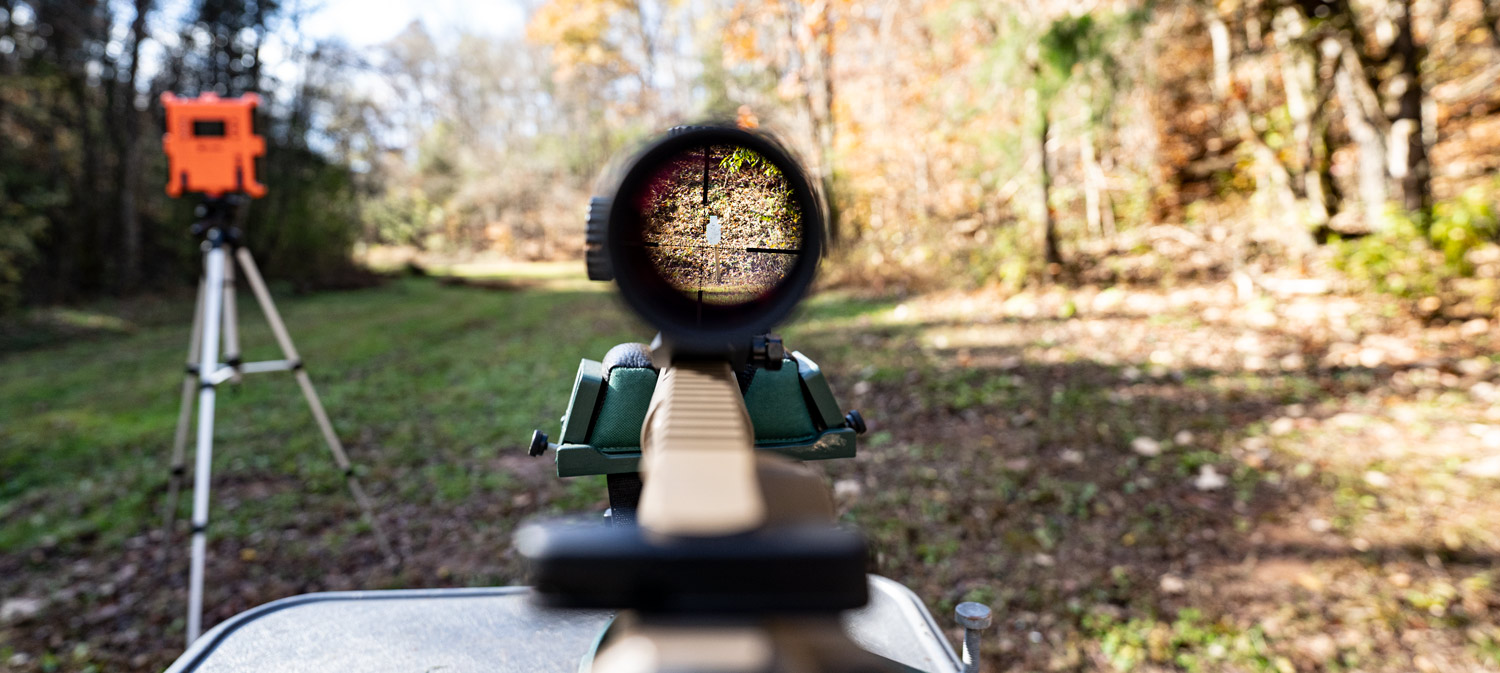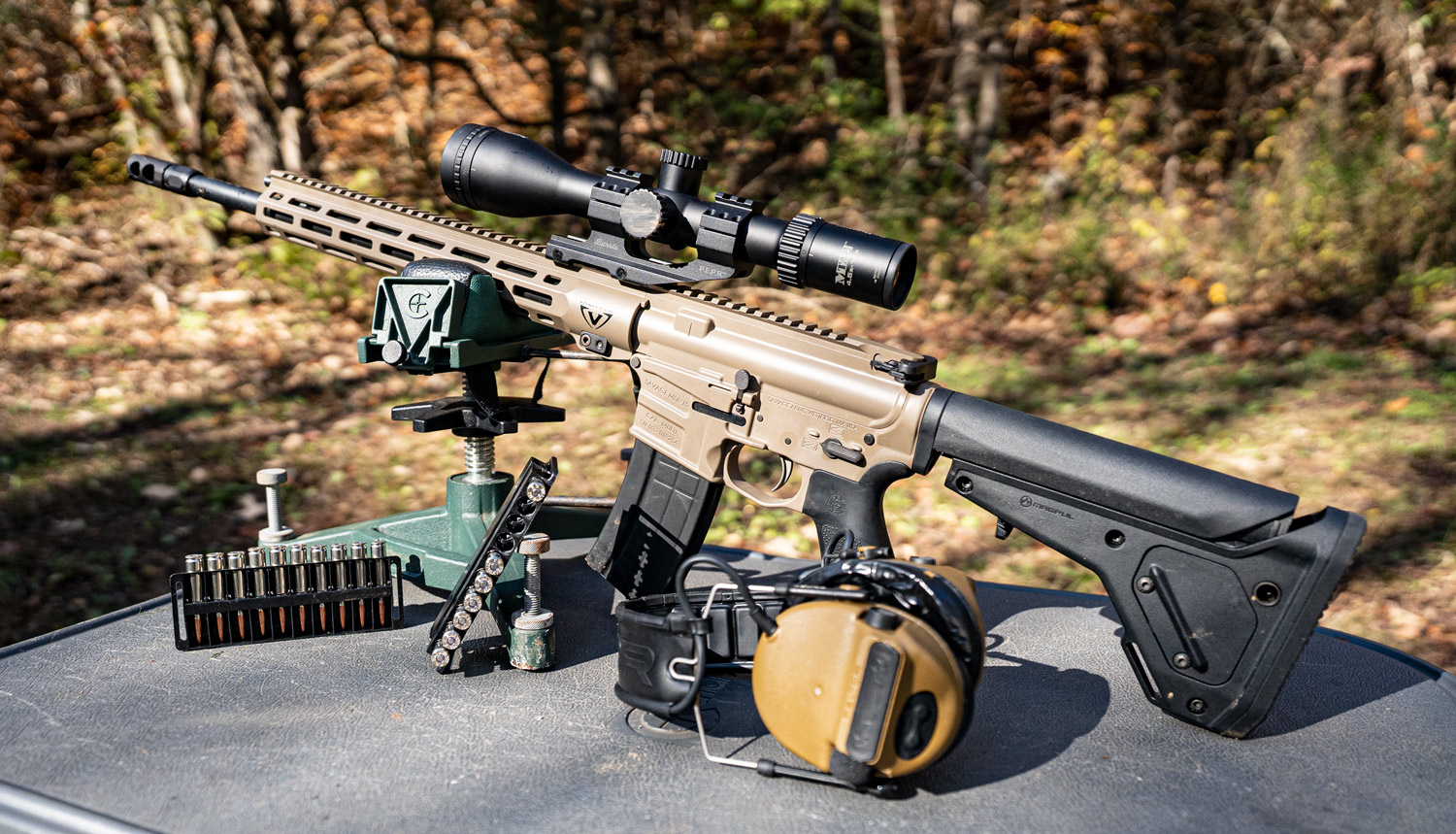A side by side comparison of the 224 Valkyrie vs 22-250 calibers. Which is superior in terms of ballistics and which of these 22-calibers is best for your shooting needs? Let’s find out!
There are many fantastic firearms choices in the United States. There are also numerous choices for ammunition. When it comes to fast and accurate shooting for medium-sized game and varmint hunting, two popular options are the modern 224 Valkyrie vs the classic .22-250 Remington.
Both offer speed and power in a smaller-caliber round, but they have surprisingly different uses, and are usually loaded into strikingly different rifles.
| .22-250 Remington | .224 Valkyrie | |
|---|---|---|
| Released | 1937 | 2017 |
| Bullet Diameter | .224 inches | 0.2245 inches |
| Rim Diameter | .473 inches | .422 inches |
| Case Length | 1.912 inches | 1.6 inches |
| Total Length | 2.35 inches | 2.26 inches |
| Bullet Weight | Roughly 30 to 60 grains | 60 - 90 grain |
.224 Valk for AR Platforms; 22-250 for Bolt-Action
For most shooters, the most important difference between these two rounds is not the cartridges themselves, but the rifles.
The .22-250 is generally used in a bolt-action rifle, while the .224 Valkyrie is used in AR-platform sporting rifles. So right from the beginning, before even looking at velocity, downrange energy, or shot trajectory, you may reach a decision based solely on firearm preference.
If you prefer high-volume shooting from an AR-style rifle, then you will likely choose the .224 Valkyrie. But if you like the classic shooting process of bolt-action firearms, then the .22-250 is likely your best choice.
.22-250: Wider Case, Longer Profile
Comparing the two cartridges side-by-side, a few differences become immediately clear. Most obvious is the case length and the distance from the rim to the “shoulders”. The .22-250 has a slightly wider rim, and the case length is significantly longer; over .3 inches longer, which doesn’t sound like much. In terms of a cartridge it’s a considerable difference though.
Essentially, the larger case, combined with bullets that are usually smaller, means the .22-250 has much different performance statistics. And if you understand the basic-level cartridges dynamics, you can likely guess how these differences will play out…
22-250 vs .224 Valkyrie: Ballistic Differences
Velocity Comparison
| Ammo Load | Muzzle Velocity (fps) | Velocity at 200 Yards |
|---|---|---|
| .22-250, 40 grain Federal Varmint & Predator | 4,200 | 3,597 |
| .224 Valkyrie, 60 grain Federal Varmint & Predator | 3,200 | 2,577 |
| .22-250, 55 grain Hornady Varmint Express | 3,680 | 2,876 |
| .224 Valkyrie, 60 grain Hornady Varmint Express | 3,300 | 2,578 |
| .22-250, 60 grain Underwood Ammo Ballistic Tip | 3,600 | N/A |
| .224 Valkyrie, 72 grain Underwood Ammo Ballistic Tip | 3,100 | N/A |
When comparing two cartridges, case size does not change from product to product. Diameter and length does not change. What does change, is the bullet. Engineers change the size and design of the bullet to fit a specific purpose. These changes can impact velocity. As we see from the stats above, .22-250 Remington ammo consistently has higher velocities, both at the muzzle and downrange.
The 40-grain .22-250 from Federal had the fastest speeds, with a blazing muzzle velocity of 4,200 feet-per-second (fps). This is no surprise, as it also carries the lightest bullet among all six products; when all other factors are the same, a lighter bullet is faster than a heavier one.
224 Valkyrie ammo offers a quick cartridge, and will win the velocity challenge when facing many other opponents, but the .22-250, which was made for speed, simply outpaces the competition.
Winner: .22-250
Energy
| Ammo Load | Muzzle Energy (ft-lbs) | Energy at 200 Yards (ft-lbs) |
|---|---|---|
| 22-250 - Federal Varmint 40 Gr. | 1,567 | 837 |
| 224 Valk - Federal Varmint 60 grain | 1,451 | 884 |
| 22-250 - Hornady Varmint Express 55 Gr. | 1,654 | 1,003 |
| 224 Valk - Hornady Varmint Express 60 Gr. | 1,451 | 885 |
| 22-250 - Underwood Ballistic Tip 60 Gr. | 1,727 | N/A |
| 224 Valk, Underwood Ballistic Tip 72 Gr. | 1,536 | N/A |
If you are using either one of these cartridges for hunting, you need to understand the energy they can deliver to the target, as this will make a big impact on the effectiveness of shot. Of course, accurate shot placement is essential, regardless of energy. But as we see from the stats above, the .22-250 Remington is clearly the more powerful round.
In all three comparisons, we see the muzzle energy for the .22-250 Remington is higher, usually about 100 to over 200 ft-lbs higher than the .224 Valkyrie.
There is one downrange stat, however, that sticks out. At 200 yards, the 60-grain .224 Valkyrie from Federal maintains an energy of 884 ft-lbs, which means it strikes with more power downrange than the comparable .22-250. So if you are looking at .224 Valkyrie with heavier bullets, you may find more powerful striking power after 200 yards or more. It may be plausible that Valkyrie, which has bullets ranging heavier than the .22-250, could be more useful for medium and long-range varmint and predator hunting.
Winner: .22-250 Remington
Trajectory
Trajectory: 22-250 vs. 224 Valkyrie
| Ammo Load | Drop at 200 Yards (100 yard Zero) |
|---|---|
| 22-250, Federal 40 Grain Varmint & Predator | 1.2 inches |
| 224 Valkyrie, Federal 60 Grain Varmint & Predator | 2.6 inches |
| Drop at 300 Yards (200 Yard Zero) | |
| 22-250, Hornady 55 Grain Varmint Express | 5.2 inches |
| 224 Valkyrie, Hornady 60 Grain Varmint Express | 6.6 inches |
The straighter the shot, the better. Or so says common shooting wisdom. Comparing this performance stat can be tough, as different manufacturers use different standards, often changing the point at which a shot is “zeroed.” Federal and Hornady provide trajectory information on the bullets we compared above, they just use different standards.
When zeroed to 100 yards, Federal’s .22-250 only drops 1.2 inches at 200 yards, while their .224 Valkyrie drops 2.6. Less than three inches of drop is a fairly impressive stat for a 60-grain bullet, but once again the .22-250 prevails.
The same is seen on the Hornady products. When zeroed to 200 yards, at 300 yards we only see 5.2 inches of drop from the .22-250, while the Valkyrie has 6.6 inches of drop.
Winner: .22-250
So Why Choose the .224 Valkyrie?
After the .22-250 beat the competition in speed, power, and trajectory, why choose the Valkyrie at all? As we said above, it’s all about gun selection. The AR platform offers a level of versatility and shooting performance that many Americans absolutely love. As you probably know, this style of rifle has soared in popularity. Many gun owners would not trade their AR-style rifle for any bolt-action. You can be use the AR for hunting, high-volume target shooting, and home defense.
While neither are a burden to shoot, there’s an ease and confidence that many shooters and hunters find with the AR-platform. For that reason, many of us are willing to forsake some of the ballistic performance for the opportunity to carry a 224 Valkyrie rifle to the range or woods. No matter which you choose in the 224 Valkyrie vs 22-250 debate, you’ll have a capable round that’s equipped to ethically bag medium-sized game without crushing your shoulder.
